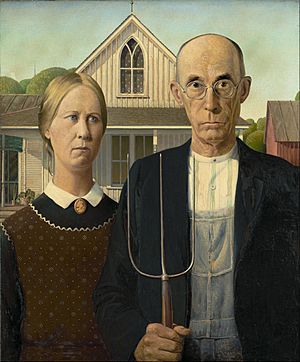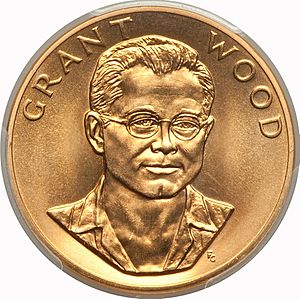Grant Wood facts for kids
Quick facts for kids
Grant Wood
|
|
|---|---|
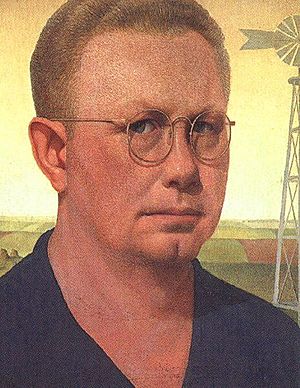
Self-portrait, 1932
|
|
| Born |
Grant DeVolson Wood
February 13, 1891 Anamosa, Iowa, United States
|
| Died | February 12, 1942 (aged 50) Iowa City, Iowa, United States
|
| Nationality | American |
| Education | School of the Art Institute of Chicago |
| Known for | Painting |
|
Notable work
|
American Gothic |
| Movement | Regionalism |
Grant Wood (born February 13, 1891 – died February 12, 1942) was a famous American painter. He is best known for his paintings that show life in the American Midwest. His most famous painting is American Gothic (1930). This painting has become one of the most recognized artworks of the 20th century.
Contents
Early Life and Art Training
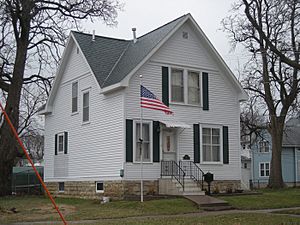
Grant Wood was born in a small town in Iowa in 1891. When he was ten, his father passed away. His mother then moved the family to Cedar Rapids.
Soon after, Grant started working as an apprentice in a metal shop. After high school, he joined an art school in Minneapolis in 1910. This school was called The Handicraft Guild. A year later, he returned to Iowa and taught in a small, one-room school. In 1913, he studied at the School of the Art Institute of Chicago. He also worked as a silversmith.
Between 1922 and 1928, Wood traveled to Europe four times. He studied many different painting styles there. He was especially interested in Impressionism and Post-Impressionism. However, it was the clear, detailed style of a 15th-century Flemish artist named Jan van Eyck that truly inspired him. Wood decided to use this precise technique in his own new artworks.
Grant Wood's Career
From 1922 to 1935, Wood lived with his mother in Cedar Rapids. He turned a carriage house loft into his own art studio. In 1932, Wood helped start the Stone City Art Colony. This was a place where artists could work together during the Great Depression.
Wood taught painting at the University of Iowa's School of Art. He worked there from 1934 to 1941. During this time, he led projects to paint murals. He also guided many students and created his own paintings. He became a very important part of the university's art community.
His Artwork
Wood was a very active painter from a young age until he died. While he is most famous for his paintings, he also worked with many other materials. These included lithography, ink, charcoal, ceramics, metal, wood, and even found objects.
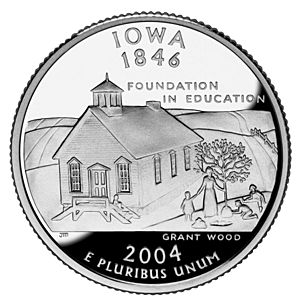
Throughout his life, he often worked for businesses in Iowa to earn money. He painted advertisements and designed things for hotels. For example, he once designed corn-themed decorations for a hotel dining room.
In 1928, he went to Munich to oversee the creation of stained glass windows. He had designed these windows for a Veterans Memorial Building in Cedar Rapids. The window was later damaged in a flood but is now being fixed.
After serving in the army as a camouflage painter, he returned to Cedar Rapids. There, he taught art to junior high students.
Regionalism Art
Grant Wood is known for being part of the American art movement called Regionalism. This movement mainly focused on artists in the Midwest. They painted scenes and themes from rural American life.
American Gothic Painting
Wood's most famous painting is American Gothic, created in 1930. It is one of the most well-known paintings in American art. It has become a widely recognized cultural symbol. Some compare its fame to that of Leonardo da Vinci's Mona Lisa or Edvard Munch's The Scream.
American Gothic was first shown in 1930 at the Art Institute of Chicago. It is still there today. The painting won a $300 prize and became news across the country. This brought Wood instant fame. Since then, it has been used and made fun of in countless advertisements and cartoons.
Wood got the idea for the painting from a small house in Eldon. This house was built in the Gothic Revival style. It had a special window shaped like a pointed arch, which gave the painting its title.
Wood decided to paint the house along with "the kind of people I fancied should live in that house." The painting shows a farmer standing next to his daughter. The models for these figures were Wood's own sister, Nan, and his dentist. His sister, Nan, always said the painting showed a daughter, not a wife. She didn't want people to think she looked old enough to be a farmer's wife! The dentist, Dr. Byron McKeeby, was from Cedar Rapids. The woman wears a dark apron that looks like clothes from the 1800s. The man holds a pitchfork, which stands for hard work.
In 1940, Wood was one of nine famous American artists hired for a special project. They were asked to paint scenes and characters from the movie The Long Voyage Home.
Death and His Legacy
Grant Wood passed away from pancreatic cancer on February 12, 1942. This was just one day before his 51st birthday. He is buried in Riverside Cemetery in Anamosa, Iowa.
When Wood died, his belongings went to his sister, Nan Wood Graham. She was the woman in American Gothic. When she passed away in 1990, her estate, including Wood's personal items and artworks, went to the Figge Art Museum in Davenport, Iowa.
A World War II ship, the SS Grant Wood, was named in his honor.
List of Works
Famous Paintings
- Spotted Man (1924)
- The Little Chapel Chancelade (1926)
- Woman with Plants (1929)
- American Gothic (1930)
- Arnold Comes of Age (1930)
- Stone City, Iowa (1930)
- Appraisal (1931)
- Young Corn (1931)
- Fall Plowing (1931)
- The Birthplace of Herbert Hoover, West Branch, Iowa (1931)
- The Midnight Ride of Paul Revere (1931)
- Plaid Sweater (1931)
- Self-Portrait (1932)
- Arbor Day (1932)
- Boy Milking Cow (1932)
- Daughters of Revolution (1932)
- Portrait of Nan (1933)
- Near Sundown (1933)
- Dinner for Threshers (1934)
- Return from Bohemia (1935)
- Death on Ridge Road (1935)
- Spring Turning (1936)
- Seedtime and Harvest (1937)
- Sultry Night (1937)
- Haying (1939)
- New Road (1939)
- Parson Weems' Fable (1939)
- January (1940)
- Iowa Cornfield (1941)
- Spring in the Country (1941)
Images for kids
-
Daughters of Revolution, 1932, Cincinnati Art Museum
-
Sentimental Ballad, 1940, New Britain Museum
-
January, 1940–41, Cleveland Museum of Art
See also
 In Spanish: Grant Wood para niños
In Spanish: Grant Wood para niños


